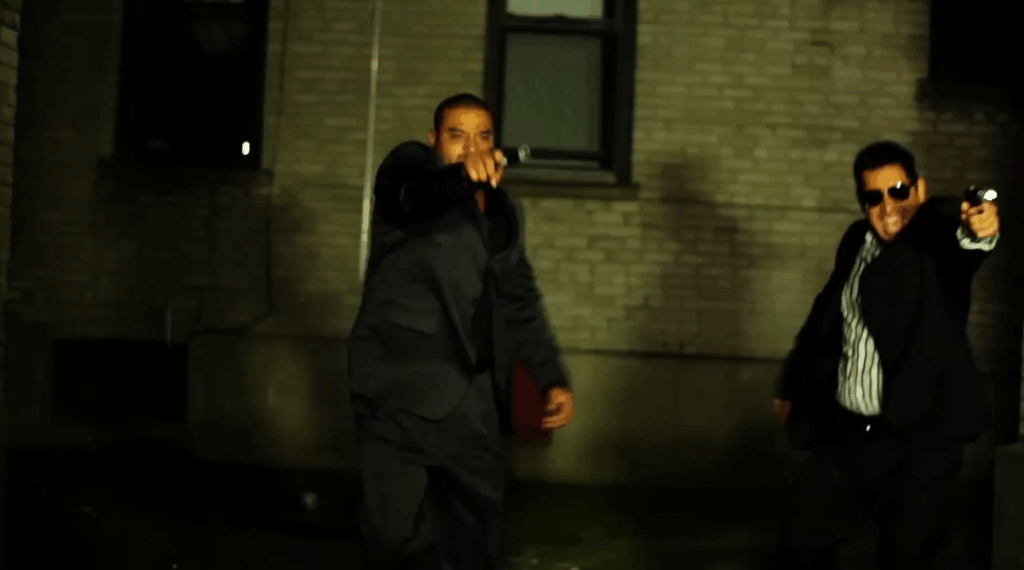Introduction: An Elusive Glimpse into the “American Nightmare”
“179th Street,” announced for a 2014 release, represents an intriguing yet obscure project within American independent cinema. Directed, written by, and starring Hanibal Luna (also known as Ariel ‘Gato’ Luna), the film plunges the viewer into the grim atmosphere of 1980s New York City, the epicenter of a war between Latino drug cartels fueled by the crack cocaine epidemic. The plot, based on two true stories, unfolds against the backdrop of the “American Dream” transforming into the “American Nightmare,” observed through the eyes of a boy chained to a radiator. Despite having a description, cast list, and a specified release date, the film is shrouded in mystery: data regarding its actual release is contradictory, and information about its availability for viewing, critical reviews, or audience reception is virtually nonexistent. This analysis aims to collect and systematize all available information about “179th Street,” exploring its production, themes, cast, and enigmatic fate in the world of cinema.
Production Details: An Authorial Project and Uncertain Status
The central figure in the creation of “179th Street” is Hanibal Luna. His multifaceted involvement – director (under the pseudonym Ariel ‘Gato’ Luna), writer (also as Ariel ‘Gato’ Luna), producer, and actor in one of the roles (Juan Muerto) – suggests a strong authorial vision or, perhaps, a production necessity typical of low-budget independent films. Luna’s filmography, according to available data, is limited, and “179th Street” appears to be his most notable project, although he is also mentioned in connection with the film “Exposed” (2016). Production was handled by Luna Empire Films , further emphasizing the personal nature of the project for the director.
Officially, the film belongs to the action and drama genres. The stated runtime is 2 hours and 8 minutes (128 minutes) , which is significant for an independent picture and suggests an ambitious narrative scope. The country of production is listed as the United States of America.
However, the key element of uncertainty is the film’s status. While several sources (Reelgood, TMDb) indicate 2014 as the release year , with TMDb specifying the US release date as December 31, 2014 , the IMDb database consistently marks the film as “In Development” at the time of data collection, applying this status to the project itself as well as the participation of the director and actors. This discrepancy raises a fundamental question: was the film actually completed and released in 2014, albeit in a limited format, or did its production halt, making the indicated release date erroneous or premature? The lack of any information about festival screenings or awards only deepens this mystery.

Plot and Thematic Context: The Crack Epidemic and the Shattered Dream
According to the synopsis provided by several sources , the film is set in New York City in the 1980s. This period was marked by the devastating crack cocaine epidemic, which drastically altered the social landscape of many American cities, particularly affecting poor neighborhoods with predominantly minority populations. The film focuses on the war between Latino drug lords, the escalation of which is directly linked to the emergence and spread of crack.
Events are shown through the perspective of a young boy who becomes an unwilling witness to the brutality and chaos while chained to a radiator. This narrative device – a child’s view of an adult world of violence – potentially heightens the drama and tragedy, creating a contrast between innocence and the surrounding reality.
The setting, although not explicitly named in the synopsis as Washington Heights, is strongly implied by the context of the 1980s, Latino drug wars, and the mention of 179th Street in the title. Washington Heights in Manhattan during that period was one of the epicenters of the crack epidemic and the associated turf wars. Historical data confirms a sharp increase in crime related to crack distribution, followed by a decline towards the end of the century, partly due to changing tactics of drug traffickers and police efforts, including the creation of a separate 33rd Precinct for the southern part of Washington Heights (south of 179th Street) in 1994. Thus, the choice of setting is deliberate, placing the film within a specific, historically accurate, and socially tense context.
The central theme of the film, explicitly stated in the description, is the transformation of the “American Dream” into the “American Nightmare.” This suggests an exploration of how the pursuit of success and prosperity in conditions of poverty, racial segregation , and systemic inequality can lead to immersion in a world of crime, violence, and destruction. Based on two true stories, the film likely aims to portray the tragic fates of individuals who became victims or active participants in the drug wars, illustrating the dark side of the pursuit of success in the specific conditions of a 1980s American metropolis.
Cast: An Eclectic Ensemble
The casting for “179th Street” presents a curious mix of recognizable character actors, figures from other fields, and the director himself, indicating an ambitious strategy for an independent project.
Among the most well-known names is Vincent Pastore, familiar to audiences from his role in the iconic series “The Sopranos.” However, his participation is marked as “rumored” in one source , while others include him in the main cast without reservation , adding another layer to the overall uncertainty surrounding the film. The cast also includes Anwan Glover, known for his role in another landmark series about drug trafficking, “The Wire” , and Elvis Nolasco, an award-winning actor (“American Crime,” “Godfather of Harlem”).
An unexpected element of the casting is the participation of famous rapper Fat Joe (Joseph Cartagena) as King Cesar Colon and model Selita Ebanks, known for her work with Victoria’s Secret, as Julissa Gomez. Attracting stars from hip-hop and the fashion industry might have been an attempt to broaden the film’s potential audience, lend it authenticity, or leverage the media weight of these figures for promotion. However, given the film’s actual obscurity, this strategy apparently did not achieve the desired result of widespread recognition.

Director Hanibal Luna himself played a character named Juan Muerto. Supporting roles were played by Fidel Vicioso, Alejandro Polanco, Ruperto Vanderpool, Greyson Cruz, Alex Mosquera (also listed as casting director ), Matthew Juganot Padilla, Jose Luna, and Ashley Gray.
The names of some characters – Jesus Christ Gomez, King Cesar Colon, Juan Muerto (Dead John) – carry clear symbolic weight. This may indicate that the film aims not only for a realistic portrayal of the criminal underworld but also for the creation of larger, possibly allegorical figures reflecting themes of power, sacrifice, death, and moral decay within the context of the proclaimed “American Nightmare.” The name of the character played by the director, “Juan Muerto,” is particularly expressive and could symbolize death itself, a ghost haunting the narrative, or a character marked by tragedy.
Below is a table with key actors and their roles, based on available data:
| Actor | Character Name | Notes | Source(s) |
|---|---|---|---|
| Vincent Pastore | Sal Mancini | Listed as “rumored” in some sources | |
| Elvis Nolasco | Jesus Christ Gomez | Award-winning actor | |
| Anwan Glover | Wayne | Known for “The Wire” | |
| Fat Joe | King Cesar Colon | Rapper | |
| Selita Ebanks | Julissa Gomez | Model | |
| Fidel Vicioso | Ramon Gomez | ||
| Hanibal Luna | Juan Muerto | Director/Writer/Producer | |
| Ruperto Vanderpool | Benny | ||
| Alejandro Polanco | Pico Fernandez | ||
| Greyson Cruz | Gordo | ||
| Alex Mosquera | Julio | Also Casting Director | |
| Ashley Gray | Nurse |
Reception and Availability: A Film Lost in Time?
One of the most striking aspects of “179th Street” is the almost complete lack of information regarding its reception by critics and audiences, as well as its availability for viewing. Available data suggests that the film, despite its announced release date and the involvement of recognizable names, did not achieve significant distribution and left no trace in the cultural space.
Major platforms like IMDb and TMDb contain no user reviews or ratings. IMDb explicitly states that ratings and reviews are absent. TMDb shows “Reseñas 0” (Reviews 0). The only quantitative indicator comes from Reelgood, which assigns the film a rating of 52 out of 100. However, this rating is based on a weighted index considering Reelgood user engagement, external metrics, content popularity, and user feedback (“loved,” “disliked”) on the platform. In the absence of other data and reviews, the significance of this single indicator is limited. It might suggest a mixed or polarizing reaction among a very small audience who may have interacted with the film’s data on this platform, but it provides no basis for serious conclusions about the film’s quality. A score near the middle of the scale often indicates ambiguous perception rather than universal acclaim or failure.
Furthermore, none of the analyzed sources mention the film’s participation in film festivals or the receipt of any awards. For independent films, festivals are often a key channel for attracting the attention of distributors and critics. Their absence in the biography of “179th Street” reinforces the hypothesis that the film was either not shown at significant venues or failed to generate interest there.
The most critical fact is the film’s current unavailability for viewing. Reelgood explicitly states that the film is currently “not available to stream, rent, or buy” in the United States. Users are only offered the option to add it to their “want to see” list to receive notifications if its status changes. This confirms that the film is effectively absent from the legal market.

The combination of these data points – the absence of reviews, ratings (except for one ambiguous score), mentions of festivals and awards, and the physical unavailability for viewing – strongly suggests that “179th Street” never received a full release or significant critical assessment after its supposed completion in 2014. The film exists as metadata on various platforms but is essentially a “ghost film,” lacking a real public life or cultural impact.
Conclusion: The Enigma of “179th Street”
Hanibal Luna’s “179th Street” remains a cinematic enigma. Announced as a 2014 independent crime drama set against the backdrop of the devastating crack epidemic in 1980s New York City , the film promised a dark exploration of the “American Nightmare” through the lens of drug cartel warfare and the perspective of an innocent child. The project was marked by the strong authorial involvement of director Hanibal Luna, who served in multiple capacities , and featured an intriguing, eclectic cast including experienced actors and stars from the music and fashion worlds.
However, the central mystery of the film lies in its contradictory status and effective absence from public access. The conflict between the stated release date (2014) and the “in development” tag on IMDb , coupled with the complete lack of reviews, awards, and the inability to legally view it , transforms “179th Street” into a phantom.
Ultimately, the story of “179th Street,” based on available information, becomes less about the plot unfolding on screen and more a case study of the challenges facing independent cinema. It serves as a reminder of how numerous films, even those with recognizable names and addressing important social themes, can fail to find an audience, encounter insurmountable distribution hurdles, and remain virtually invisible in an oversaturated media landscape. “179th Street” exists as a collection of database entries, a potentially ambitious project that never realized its potential for a wide audience, its artistic content remaining hidden, perhaps forever.


